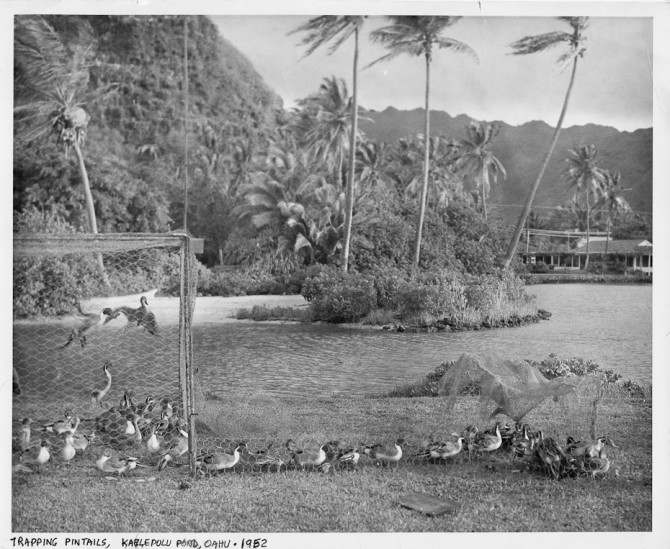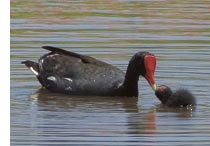 ‘Alae ‘Ula ~ Hawaiian Gallinule (Moorhen)
‘Alae ‘Ula ~ Hawaiian Gallinule (Moorhen)
Gallinula chloropus sandvicensis
This 13-inch tall slate-gray bird has black feathers on its neck and head with white feathers on its flanks and under its tail. It has a bright red frontal shield and bill with a yellow tip. Its legs and rather large unwebbed feet are yellowish-green.
The ‘Alae ‘Ula is very secretive, usually remaining close to dense vegetation and hiding quickly when it senses danger.
Gallinules feed on aquatic insects, mollusks, algae, water plants and grasses. They build nests of reeds and other aquatic vegetation and lay clutches of between 6 and 13 eggs. Young chicks are able to run and swim within a few hours of hatching. They are covered with black down and have a bright red bill.
The ‘Alae ‘Ula is an endemic water bird (found naturally only in Hawaii) that is an endangered species with a total population perhaps in the hundreds.
You can find gallinules at the Ka’elepulu Wetland and at the small island off the Kukilakila townhouses.
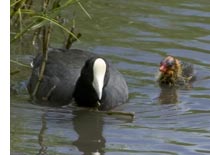 ‘Alae Ke’oke’o ~ Hawaiian Coot
‘Alae Ke’oke’o ~ Hawaiian Coot
Fulica alai
The Hawaiian Coot is a close relative of the American Coot and was only recognized as a distinct species in 1993.
The adult coot stands 14 inches tall and is a solid gray-black with a darker neck and head. It has a white bill and bulbous frontal shield. A few have a red shield and white bill with small black markings. White undertail feathers are easy to see when they are swimming or diving for food in the shallow water. Downy chicks are black with reddish-orange spiky head plumage. They are able to run and swim soon after hatching but remain in contact with their parents by frequent calling. Juveniles have paler gray feathers and grayish bills.
‘Alae Ke’oke’o eat seeds and leaves of aquatic plants, tadpoles, insects and small fish. Their calls are a chicken-like “keck-keck” and other clucks and creaks.
There were an estimated 500 coots on Ka’elepulu Pond in 1947. In 2004, 50 were observed in the Ka’elepulu Wetland and nearby lake waters. They are an endangered species.
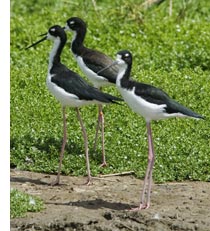 ‘Ae’o ~ Hawaiian Stilt
‘Ae’o ~ Hawaiian Stilt
Himantopus mexicanus knudseni
This slender, endemic wading bird stands 16 inches tall. Their black back is glossy in males and brown-tinged in females. Juveniles have a brownish back with white patches on their cheeks.
The Ae’o flies with its long pink legs stretched out straight behind. At Ka’elepulu Wetland, they are often seen in small groups feeding on water insects, worms, crabs, small fish and the seeds and roots of waterplants.
Listen for its soft muted call when resting and its loud, sharp “kip-kip-kip” in flight or when disturbed on the ground.
The Hawaiian Stilt nests in shallow depressions lined with stone and twigs. Adults will use the “broken wing act” to lure intruders away from their nests.
The Ae’o is an endangered species. Up until 1941 it was hunted for sport, now it numbers around 1,500. Like all of Hawaii’s endangered waterbirds, a major cause of its decline has been habitat destruction due to drainage of marshes and wetlands.
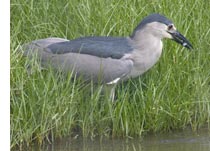 ‘Auku’u ~ Black-Crowned Night-Heron
‘Auku’u ~ Black-Crowned Night-Heron
Nycticorax nycticorax hoactli
The ‘Auku’u is a large bird, standing 26 inches tall with a wingspan of 45 inches. They have a black cap, back and bill with a soft gray chest and darker gray wings. Adult males in breeding plumage have four to five long white head plumes and females have two to three plumes. Juvenile herons look distinctly different and are brown with white streaks.
The heron is active at night but also forages during the day, using a “stand and wait” technique to catch fish, frogs and other aquatic life. It has been known to prey on young chicks and is therefore a threat to the endangered birds who share their habitat. It nests in trees, laying two to four bluish green eggs. ‘Auku’u have a deep croak or “kwock” given in flight or when startled. It is not endangered.
 Koloa ~ Hawaiian Duck
Koloa ~ Hawaiian Duck
Anas wyvilliana
Koloa are similar to and probably derived from the Mallard. Both sexes are mottled brown, resembling a small dark female Mallard. Their flight feathers are green to blue and bordered on both sides by white. Their feet and legs are orange. The bill is olive green in males and a dull orange or gray with a dark saddle in females. Males are darker than females and tend to chestnut coloring below.
Koloa quack like Mallards, but softer and are not as vocal. There are few pure Koloa on Oahu, most are Mallard-Koloa hybrids. You will probably see only hybrids at Ka’elepulu Wetland.
Koloa eat a wide variety of food including snails, earthworms, dragonflies, algae and wetland plants. They are listed as an endangered species.
Other Birds that Visit Ka’elepulu Pond and Wetland
Sanderlings, Great Frigatebirds, Golden Plovers, Wandering Tattlers, Ruddy Turnstones and Cattle Egrets are frequent visitors to our wetland. There are also 6 white Geese and 1 Graylag Goose who were once domestic. A lone Lesser Canada Goose called the lake home for many years.
